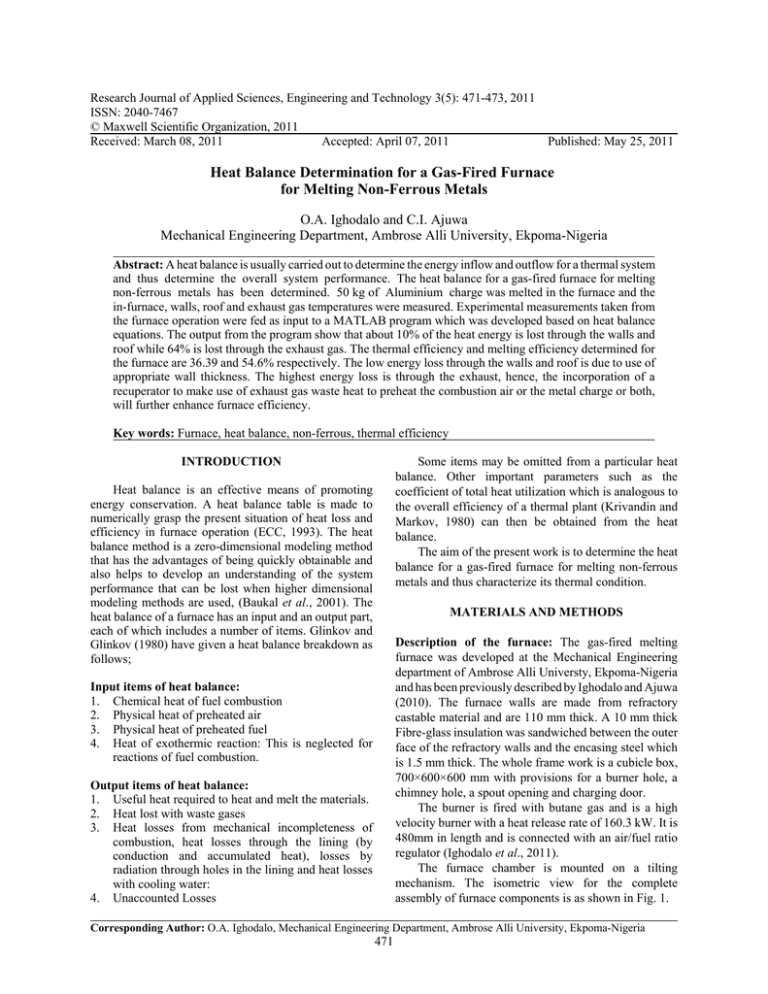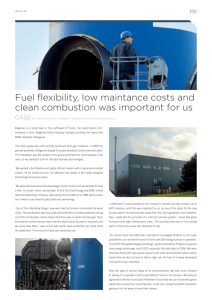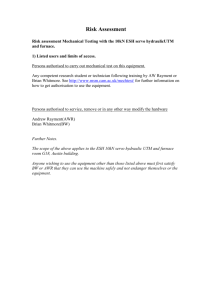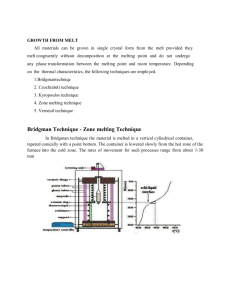Research Journal of Applied Sciences, Engineering and Technology 3(5): 471-473,... ISSN: 2040-7467 © Maxwell Scientific Organization, 2011
advertisement

Research Journal of Applied Sciences, Engineering and Technology 3(5): 471-473, 2011 ISSN: 2040-7467 © Maxwell Scientific Organization, 2011 Received: March 08, 2011 Accepted: April 07, 2011 Published: May 25, 2011 Heat Balance Determination for a Gas-Fired Furnace for Melting Non-Ferrous Metals O.A. Ighodalo and C.I. Ajuwa Mechanical Engineering Department, Ambrose Alli University, Ekpoma-Nigeria Abstract: A heat balance is usually carried out to determine the energy inflow and outflow for a thermal system and thus determine the overall system performance. The heat balance for a gas-fired furnace for melting non-ferrous metals has been determined. 50 kg of Aluminium charge was melted in the furnace and the in-furnace, walls, roof and exhaust gas temperatures were measured. Experimental measurements taken from the furnace operation were fed as input to a MATLAB program which was developed based on heat balance equations. The output from the program show that about 10% of the heat energy is lost through the walls and roof while 64% is lost through the exhaust gas. The thermal efficiency and melting efficiency determined for the furnace are 36.39 and 54.6% respectively. The low energy loss through the walls and roof is due to use of appropriate wall thickness. The highest energy loss is through the exhaust, hence, the incorporation of a recuperator to make use of exhaust gas waste heat to preheat the combustion air or the metal charge or both, will further enhance furnace efficiency. Key words: Furnace, heat balance, non-ferrous, thermal efficiency Some items may be omitted from a particular heat balance. Other important parameters such as the coefficient of total heat utilization which is analogous to the overall efficiency of a thermal plant (Krivandin and Markov, 1980) can then be obtained from the heat balance. The aim of the present work is to determine the heat balance for a gas-fired furnace for melting non-ferrous metals and thus characterize its thermal condition. INTRODUCTION Heat balance is an effective means of promoting energy conservation. A heat balance table is made to numerically grasp the present situation of heat loss and efficiency in furnace operation (ECC, 1993). The heat balance method is a zero-dimensional modeling method that has the advantages of being quickly obtainable and also helps to develop an understanding of the system performance that can be lost when higher dimensional modeling methods are used, (Baukal et al., 2001). The heat balance of a furnace has an input and an output part, each of which includes a number of items. Glinkov and Glinkov (1980) have given a heat balance breakdown as follows; MATERIALS AND METHODS Description of the furnace: The gas-fired melting furnace was developed at the Mechanical Engineering department of Ambrose Alli Universty, Ekpoma-Nigeria and has been previously described by Ighodalo and Ajuwa (2010). The furnace walls are made from refractory castable material and are 110 mm thick. A 10 mm thick Fibre-glass insulation was sandwiched between the outer face of the refractory walls and the encasing steel which is 1.5 mm thick. The whole frame work is a cubicle box, 700×600×600 mm with provisions for a burner hole, a chimney hole, a spout opening and charging door. The burner is fired with butane gas and is a high velocity burner with a heat release rate of 160.3 kW. It is 480mm in length and is connected with an air/fuel ratio regulator (Ighodalo et al., 2011). The furnace chamber is mounted on a tilting mechanism. The isometric view for the complete assembly of furnace components is as shown in Fig. 1. Input items of heat balance: 1. Chemical heat of fuel combustion 2. Physical heat of preheated air 3. Physical heat of preheated fuel 4. Heat of exothermic reaction: This is neglected for reactions of fuel combustion. Output items of heat balance: 1. Useful heat required to heat and melt the materials. 2. Heat lost with waste gases 3. Heat losses from mechanical incompleteness of combustion, heat losses through the lining (by conduction and accumulated heat), losses by radiation through holes in the lining and heat losses with cooling water: 4. Unaccounted Losses Corresponding Author: O.A. Ighodalo, Mechanical Engineering Department, Ambrose Alli University, Ekpoma-Nigeria 471 Res. J. Appl. Sci. Eng. Technol., 3(5): 471-473, 2011 Fig. 1: Isometric view of the Furnace, Ighodalo (2010) Table 1: Input to heat balance program rec = 0; %control for air preheating time = 1.83;% melting time in hr. M=50; % Mass of metal kg Cm = 1.045; %specific heat of metal kJ/kg.k Tm = 702; %melting temp for metal in kelvin in ºC Mc = 3.3; % mass of metal container in kg (set to zero for direct charge firing) Cc = 0.46; % specific heat of container (steel) kJ/kg.k Lf = 387; % latent heat of fusion for metal kJ/kg Tac = 1533; % actual temperature of furnace ºC B = 12.8; % fuel used in kg BP = B/time; % fuel used per period twg = 730.9; % average temperature of waste gases in ºC tpre = 0; % temperature of preheated air in ºC x = [749.4 749.4 749.4 749.4 802]; %final inner (walls 1 to 4 & roof) surface temp ºC Tos = 77.5; %ave outer wall surface temperature ºC Tor = 72; %ave outer roof surface temperature ºC Experimental measurements: 50 kg of Aluminium charge was loaded into the furnace and melted in total time of 110 min with in-furnace temperature of 1533ºC. The quantity of gas consumed was 12.8 kg. The infurnace temperature was measured with a suction pyrometer. This was used to estimate the inside surface wall temperatures using the heat conduction equation for multiple walls. The estimated temperature for walls is 749.4ºC. The inner roof surface, outer roof surface and outer wall surface temperatures of the furnace were measured directly using infra-red thermometer. The values obtained are 802, 77.5 and 72ºC, respectively. The exhaust or waste gas temperature was also measured. based on the equations. The following items were disregarded; physical heat of preheated air and fuel, heat losses by radiation through open furnace doors, incompleteness of combustion and to cooling water. The values obtained from the experimental measurements and other measured parameters served as input to the heat balance program. The input values are shown in Table 1, while the output from the program is shown in Table 2. RESULTS AND DISCUSSION The output from the heat balance show that less than 10% of the total heat supplied was utilized in melting the charge while 64% of the heat is lost with the waste gases, The coefficient of total heat utilization is 36.39%. The coefficient of total heat utilization is also synonymous Heat balance program: The equations for the heat balance items have been given by Krivandin and Markov (1980). A MATLAB computer program was developed 472 Res. J. Appl. Sci. Eng. Technol., 3(5): 471-473, 2011 Table 2: Output from Heat balance program >> No Air Pre-heating actual furnace temp Tac = 1533.000 ºC fuel used per period B = 12.800 kg fuel used per hour BP = 6.995 kg/hr enthalpy of waste gases hwg = 797.480 kJ/kg specific heat of waste gases in kJ/kg.k = 1.138 kJ/kg.k average temperature for wall1 in ºC = 158.514 average temperature for wall2 in ºC = 158.514 average temperature for wall3 in ºC = 158.514 average temperature for wall4 in ºC = 158.514 average temperature for roof in ºC = 167.910 A. heat input in kJ/kg (percent) 1. Heat of fuel combustion. QCH = 586240.00 (100.0%) 2. Heat of preheated air. QPA = 0.00 (0.0%) Total Heat Input = 5.86e+005 (100.0%) B. heat output in kJ/kg (%) 1. Heat spent to melt metal. QM = 54462.00 (9.3%) 2. Heat spent to heat metal container. QC = 2327.09 (0.4%) 3. Heat lost with waste gases. QWG = 372889.05 (64.0%) 4. Heat accumulated & lost through walls &roof. QTWR = 57635.61 (9.9%) 5. Heat lost by outer wall surfaces. QTS = 7758.03 (1.3%) 6. Unaccounted Heat loss. QUN = 87936.00 (15.1%) Total Heat output = 5.86e + 005 (100.0%) C. Thermal condition indicators Unit Heat Consumption kJ/kg of metal = 11724.80 kJ/kg of metal Specific fuel Consumption kg/kg of metal = 19.99 kg/kg coefficient of useful heat utilization Nuhu = 10.24% coefficient of total heat utilization Nhu = 36.39% Melting Rate MR = 27.32 kg/h >> The Furnace melting rate is 27.32 kg/h, and when matched with the design capacity of 50 kg/h, this will give a design or melting efficiency of 54.6%. This is considered quite good. CONCLUSION The heat balance for the furnace under study has shown that a greater portion of the energy loss from the furnace is through the waste gas. The furnace efficiency can thus be enhanced by the incorporation of a recuperator to make use of exhaust gas waste heat to preheat the combustion air or the metal charge or both. The use of appropriate wall thickness and insulation are also factors that minimized the energy loss through the walls and roof thus enhancing energy conservation and efficiency. ACKNOWLEDGMENT The part funding received from the Ambrose Alli University Ekpoma-Nigeria for this research work is gratefully acknowledged. REFERENCES Baillargeon, P., D. Lecklerc and H. Zahar, 1998. Guide to energy efficiency in Aluminum smelters, 1998 Project report Aluminum association of Canada, pp: 53. Baukal, C.E., V.Y. Gershtein and X. Li, 2001. Computational Fluid Dynamics in Industrial Combustion.CRC Press, USA, pp: 630. ECC, 1993. Project Report: Seminar on Energy Conservation in Glass Industry. Published by the Energy Conservation Centre (E.C.C), Japan, pp: 38. Glinkov, M.A. and G.M. Glinkov, 1980. A General Theory of Furnaces. Mir Publishers, Moscow, pp: 286. Ighodalo, O.A., 2010. Development of a furnace for melting non-ferrous metals. Ph.D. Thesis, Department of Mechanical Engineering, Ambrose Alli University, Epoma-Nigeria, pp: 240. Ighodalo, O.A. and C.I. Ajuwa, 2010. Development and performance evaluation of a gas-fired melting furnace for non-ferrous metals. Int. J. Eng., 4(1): 57-64. Ighodalo O.A., C.I. Ajuwa and B.R. Iredje, 2011. Development and performance evaluation of a high velocity burner. Am. J. Sci. Indus. Res., 2(1): 49-53. Krivandin, V.A. and B.L. Markov, 1980. Metallurgical Furnaces. Mir Publishers, Moscow, pp: 509. with the overall thermal efficiency. According to Baillargeon et al. (1998), the overall energy efficiency of a typical Furnace using a burner fed with cold combustion air has not generally exceeded 30% and approximately 50 to 60% of energy consumed by the Furnace is lost in combustion gases escaping through the stack. There is an improved efficiency with the present furnace by 6.39% and the percentage of heat lost to waste gases of 64% though higher, is still close to the limit given by Baillargeon et al. (1998). The heat accumulated and lost through the walls and roof is approximately 10%, this is quite low and is an indication that the wall thickness and insulation material adopted for the furnace design are quite adequate and have enhanced heat conservation. The heat balance has produced a better thermal efficiency value than the approximate value of 33% previously determined for the furnace by Ighodalo and Ajuwa (2010). 473






